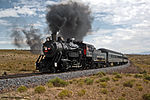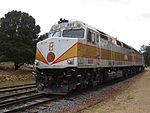
The Atchison, Topeka and Santa Fe Railway, often referred to as the Santa Fe or AT&SF, was one of the largest Class 1 railroads in the United States.

The California State Railroad Museum is a museum in the California State Parks system that interprets the role of railroads in the West. It is located in Old Sacramento State Historic Park at 111 I Street, Sacramento, California.

The Fred Harvey Company was the owner of the Harvey House chain of restaurants, hotels and other hospitality industry businesses alongside railroads in the Western United States. It was founded in 1876 by Fred Harvey to cater to the growing number of train passengers.
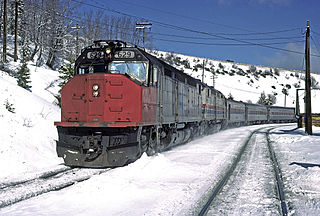
The EMD SDP40F was a six-axle 3,000 hp (2.2 MW) C-C diesel–electric locomotive built by General Motors Electro-Motive Division (EMD) from 1973 to 1974. Based on Santa Fe's EMD FP45, EMD built 150 for Amtrak, the operator of most intercity passenger trains in the United States. Amtrak, a private company but funded by the United States government, had begun operation in 1971 with a fleet of aging diesel locomotives inherited from various private railroads. The SDP40F was the first diesel locomotive built new for Amtrak and for a brief time they formed the backbone of the company's long-distance fleet.

Atchison, Topeka and Santa Fe 3751 is a class "3751" 4-8-4 "Heavy Mountain" type steam locomotive built in May 1927 by the Baldwin Locomotive Works in Eddystone (Philadelphia), Pennsylvania for the Atchison, Topeka & Santa Fe Railway (ATSF). No. 3751 was the first 4-8-4 steam locomotive built for the Santa Fe and was referenced in documentation as type: "Heavy Mountain", "New Mountain", or "Mountain 4-wheel trailer". No. 3751 served in passenger duties until being retired in 1957.

The Grand Canyon Limited was one of the named passenger trains of the Atchison, Topeka and Santa Fe Railway. It was train Nos. 23 & 24 between Chicago, Illinois, and Los Angeles, California.

Atchison, Topeka and Santa Fe 2926 is a class "2900" 4-8-4 type steam locomotive built in May 1944 by the Baldwin Locomotive Works for the Atchison, Topeka & Santa Fe Railway (ATSF). It was used to pull passenger and fast freight trains, mostly throughout New Mexico, until it was retired from revenue service in 1953. Three years later, it was donated to Coronado Park in Albuquerque for static display.
Xanterra Travel Collection® is a privately owned American park and resort management company based in Greenwood Village, Colorado, controlled by entertainment magnate Philip Anschutz. Denver-based billionaire Anschutz, who has an extensive history of developing and operating mineral, railroad, newsmedia and entertainment enterprises, is one of the largest private promoters of live events in the world, most notably soccer.
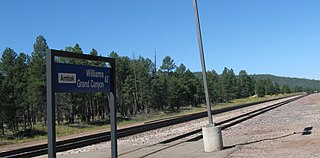
Williams Junction station was an Amtrak train station on the Southwest Chief route, located three miles (4.8 km) southeast of Williams, Arizona in the Kaibab National Forest. The station primarily served passengers travelling to the Grand Canyon via the Grand Canyon Railway.

Williams Depot is a privately owned train station in Williams, Arizona. It is the southern terminus of the Grand Canyon Railway line.

Grand Canyon Depot, also known as Grand Canyon Railroad Station, was constructed in 1909–10 for the Atchison, Topeka and Santa Fe Railway at the South Rim of the Grand Canyon, in what is now Grand Canyon National Park. It is one of three remaining railroad depots in the United States built with logs as the primary structural material. The station is within 330 feet (100 m) of the rim of the canyon, opposite the El Tovar Hotel, also built by the railroad. The depot is designated a National Historic Landmark, is listed the National Register of Historic Places, and is included in the Grand Canyon Village National Historic Landmark District.

Atchison, Topeka and Santa Fe 3759 is a class 3751 4-8-4 "Heavy Mountain" type steam railway locomotive built by the Baldwin Locomotive Works in 1928. It is on display in Locomotive Park, located between Andy Devine Avenue and Beale Street in Kingman, Arizona. The park was established in August 1957 with AT&SF 3759 donated to the City of Kingman in recognition of Kingman's history with the railroad. The locomotive is termed a Mountain type on the nearby information plaque, and also in the city's descriptive material which is correct for the Santa Fe. ATSF 4-8-4s were referenced in documentation as type "Heavy Mountain", "New Mountain" or "Mountain 4-wheel trailer."

Atchison, Topeka and Santa Fe 3415 is a preserved class "3400" 4-6-2 "Pacific" type steam locomotive built in June 1919 by the Baldwin Locomotive Works for the Atchison, Topeka and Santa Fe Railway. Retired in 1954, it sat in Eisenhower Park in Abilene, Kansas, until 1996. At that point, it was put on display in the Abilene and Smoky Valley yard. Restoration began in 2005 and was completed in early 2009. As of October 7, 2023. No. 3415 is out of service, awaiting its federally mandated 15-year overhaul.

The Southern California Railway Museum, formerly known as the Orange Empire Railway Museum, is a railroad museum in Perris, California, United States. It was founded in 1956 at Griffith Park in Los Angeles before moving to the former Pinacate Station as the "Orange Empire Trolley Museum" in 1958. It was renamed "Orange Empire Railway Museum" in 1975 after merging with a museum then known as the California Southern Railroad Museum, and adopted its current name in 2019. The museum also operates a heritage railroad on the museum grounds.

Grand Canyon Railway 4960 is a preserved O-1A class 2-8-2 "Mikado" type steam locomotive built in August 1923 by the Baldwin Locomotive Works for the Chicago, Burlington and Quincy (CB&Q) Railroad. It was used by the CB&Q to pull freight trains, until 1958, when the locomotive pulled its first excursion fantrip, as part of the railroad's steam excursion program.

The Santa Fe 2900 Class was a series of 30 4-8-4 type steam locomotives built between 1943 and 1944 for Atchison, Topeka and Santa Fe Railroad and pulled freight and passenger trains until retirement in the early to late-1950s.
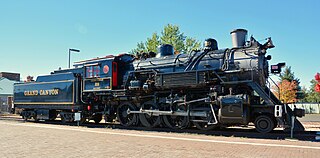
Grand Canyon Railway No. 29 is an SC-3 class 2-8-0 "Consolidation" type steam locomotive, built by ALCO's Pittsburgh Works in 1906 for the Lake Superior and Ishpeming Railroad (LS&I) in Upper Michigan. The sole member of the LS&I's SC-3 class, it was originally numbered 14, but was renumbered to 29 in 1924. Having gone through two major rebuilds to upgrade its performance, No. 29 served the LS&I in pulling freight and iron ore trains until being retired in 1956.

Lake Superior and Ishpeming Railroad No. 18 is an SC-4 class 2-8-0 “Consolidation” type steam locomotive, built by ALCO’s Pittsburgh Works in 1910 for the Lake Superior and Ishpeming (LS&I) Railroad in Upper Michigan. Originally numbered 11, the locomotive was renumbered to 18 in 1924, and it served the railroad, until it discontinued steam operations in 1962. No. 18 was subsequently sold to the Marquette and Huron Mountain tourist railroad, where it was put into storage alongside other steam locomotives.

Spokane, Portland and Seattle Railway No. 539 is the only preserved example of the class O-3 2-8-2 "Mikado" steam locomotive. It was built by the American Locomotive Company in 1917 for the Northern Pacific Railway as engine No. 1762. It was sold to the Spokane, Portland and Seattle Railway and renumbered 539, in August 1944. It was reconfigured and converted to oil burning in January 1946. The locomotive was retired in 1957, and it was displayed in Esther Short Park, Washington, until 1997. That year, it was moved to Battle Ground for a potential restoration that never came to fruition. In 2007, it was acquired by the Grand Canyon Railway and moved to Williams, Arizona for an operational restoration that also never came to fruition. In 2019, No. 539 was purchased again by the Port of Kalama, who moved it back to Washington and put it on static display inside the Port's Interpretive Center that was constructed in 2014.






